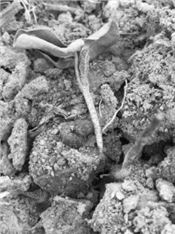|
Insects On The Radar
DR. SCOTT STEWART
JACKSON, TENN.
This article is a reminder about some critters we need to watch for in the coming few weeks. It’s easy to let something slip through the cracks when you are distracted with planting operations. Try to circle back to emerging fields as best you’re able during the first 2-3 weeks after planting to check on plant stands and other issues.
Wheat – True armyworm is the insect most likely to cause issues at this time of year. Even so, it doesn’t commonly require treatment. However, excessive defoliation before the dough stage can reduce yields, and this pest is easily controlled with pyrethroid insecticides. The treatment threshold is 6-8 larvae per square foot while wheat is still in the milk stage. You can read more about true armyworms at https://guide.utcrops.com/wheat/wheat-insect-guide/armyworms/.
You might see true armyworms in other crops, especially along grassy edges and also if you had a green cover crop that contained wheat, barley, oats or cereal rye. Larvae will move from feeding on the cover crop to the emerging cash crop, and if the timing works our poorly, it can cause problems.
Soybean – The biggest call I get this time of year is defoliation cause by bean leaf beetles. They often congregate on the first emerging soybean fields in the area. This seldom cause economic injury, but the defoliation can catch your eye. Don’t be fooled by color. The adult beetles has several color variations, including spotted and unspotted versions. You can see pictures of the beetles and their feeding damage at https://guide.utcrops.com/soybean/soybean-insect-guide/bean-leaf-beetle/.
Slugs may cause similar defoliation, so if you are not seeing bean leaf beetles, dig around under the residue to see if slugs are the culprit. Don’t get excited by slugs if all you are seeing is some defoliation. But they can cause stand loss by feeding on seeds and stems. Make sure that seed furrow closed behind the planter or you’ll make a slug highway.
Corn – A primary concern here is scouting for stand establishment and checking for insect injury, most of which occurs underground and you can’t really do anything about it after planting. Cutworms are the exception. Be sure to scout for cut plants and make treatments as needed. Additional information about treatment thresholds and insecticide recommendations can be found at https://guide.utcrops.com/corn/corn-insect-guide/cutworms/.
Cotton – I wrote an article last week (linked below) related to the thrips infestations predictor model. Keep updated on the model predictions for your area as we start planting. Current prediction for West TN indicate moderate risks of thrips injury for planting dates before mid-May, but that can change depending on weather events and your location. This tool can help you prioritize if and when you need to make a foliar insecticide application to control thrips. https://news.utcrops.com/2020/04/using-the-thrips-infestation-predictor-for-cotton/ ∆
DR. SCOTT STEWART: IPM Extension Specialist, University of Tennessee

Black cutworm and cut cotton plant
|
|